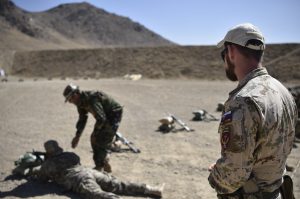By Catherine Putz
 Costs are all-too-often spoken of in dollar signs and bottom lines, rather than an accounting of coffins. And when death is factored in, war-related deaths get the headlines, or sometimes the nigh uncountable number of civilian casualties gets top billing. But the ongoing reconstruction efforts in Afghanistan have had their human costs, too.
Costs are all-too-often spoken of in dollar signs and bottom lines, rather than an accounting of coffins. And when death is factored in, war-related deaths get the headlines, or sometimes the nigh uncountable number of civilian casualties gets top billing. But the ongoing reconstruction efforts in Afghanistan have had their human costs, too.
In a report released this week, the Special Inspector General for Afghanistan Reconstruction (SIGAR) noted that the bulk of its work has been in tracking the financial costs of reconstruction and stabilization activities in the war-torn country but that relatively little effort “has been made up to now to track the human costs – the number of people killed, wounded, or kidnapped – to accomplish these activities.”
As SIGAR pointed out, “This has left policy makers with an incomplete picture of the true cost of our efforts in Afghanistan.”
In dollar signs, the costs of the war in Afghanistan depend on which data you look at, which budgets are counted. In its latest quarterly report, SIGAR noted that cumulative appropriations for reconstruction and related activities in Afghanistan since the 2002 fiscal year totaled approximately $137.0 billion. The Department of Defense, in turn, stated in a report that covered the costs of war since September 11, 2001 through September 30, 2019 that Afghan operations (Operation Enduring Freedom and Operation Freedom’s Sentinel) have cost a combined $776 billion.
The war in Afghanistan has been expensive in more than one way.
In its review, SIGAR looked at casualties with relation to reconstruction or stabilization efforts; this did not include casualties that took place during combat or counterterrorism missions, enemy attacks on military sites, accidents, or casualties that took place in nonreconstruction related locations, such as public gatherings, banks, mosques, or private homes.
Of note, SIGAR did count casualties incurred during military and civilian logistics resupply missions, if those missions were specifically carrying reconstruction materials. Other casualties resulting from attacks on convoys were not counted. SIGAR also did an accounting of kidnappings, not usually included.
By SIGAR’s account, noted in the report as a conservative number, there were 5,135 casualties in Afghanistan associated with reconstruction or stabilization missions, from 2002 through the end of December 2018. The majority of the casualties counting in SIGAR’s report occurred during the height of reconstruction efforts between 2008 and 2011.
Of those casualties, a little less than half — 2,214 — were deaths; the remaining 2,921 were injuries. In addition, SIGAR identified more than 1,100 kidnappings or individuals who went missing.
SIGAR categorized the casualties according to the specific stabilization or reconstruction activity (security, governance and development, and humanitarian) and origin (U.S. service member, U.S. civilian, Afghan, coalition forces, third country national or TCN, and unknown). The “governance and development” category was further broken down into submissions, including governance, construction, road construction, demining, election activities, and counternarcotics.
Unsurprisingly, Afghans have borne the brunt of the war’s human costs. According to SIGAR, “1,447 Afghan civilians were killed, 2,008 wounded, and 1,003 kidnapped while performing reconstruction or stabilization missions.”
At least 284 Americans were killed in Afghanistan while performing reconstruction or stabilization missions, SIGAR says. The bulk of those killed, 216, were U.S. service members with the remainder being U.S. civilians (generally government employees or contractors.)
Security missions, in which U.S. service members were assigned to train and mentor Afghan military counterparts, were the most dangerous for Americans. Casualties that fall under the “governance and development” category were more numerous for other groups, primarily Afghans. For example, of the 815 casualties related to construction activities, 79 percent were Afghans.
Ultimately, this data will come as no surprise to those who have been closely following the war. But policymakers are not as aware. In concluding the report, SIGAR writes, “this review shows that we do not adequately capture the human cost of conducting reconstruction and stabilization projects while combat operations are still ongoing, especially third country nationals and Afghans. Unless the U.S. Government considers the human costs, the true costs of reconstruction and stabilization efforts in Afghanistan are not accurately captured.”
No comments:
Post a Comment